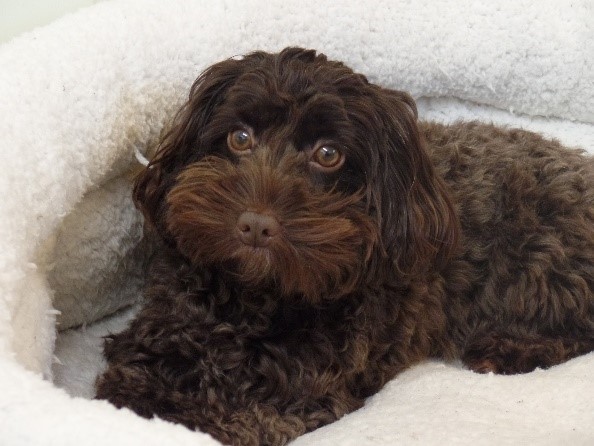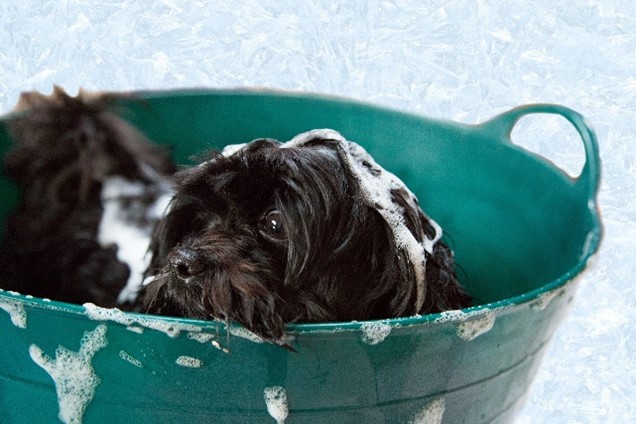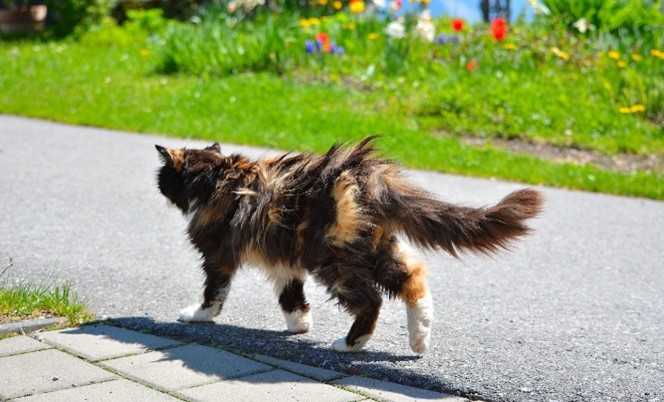
How Veterinary Staff can help Pets cope with the Grooming experience
With the recent increase in the popularity of poodle crosses, and exotic cat breeds such as Ragdolls, many of the new puppies and kittens that are presented to vet practices are going to need regular grooming throughout their lives to prevent their coats becoming tangled and matted. Some caregivers are able to brush, bath and clip their own pets, but not always in a manner which enables the pets to remain relaxed and comfortable. Others rely on the services of professional groomers. Older animals may lose the ability to groom themselves properly as a result of stiffness or pain, for example due to spinal conditions, dental problems or other oral and/or orthopaedic pain – these individuals will need help to keep their coats in good condition as well as treatment of the underlying problem.

First Experience
Their first professional grooming experience can be scary and stressful for pets who have not been prepared for the sort of handling that is involved, and are not comfortable with unfamiliar people. Even grooming at home by their caregivers can be stressful for pets who have not been gently introduced to the process, especially if they already have some mats or tangled fur when the caregiver starts to brush them.
Role of Veterinary Staff
Veterinary staff can play a role in preventing and reducing distress by providing appropriate advice to caregivers of puppies, kittens and rabbits if their pets are fluffy or long-haired. The main message that needs to be communicated with respect to grooming is that ‘just getting it done’ can adversely affect the welfare of pets and their relationship with their caregivers, if the emotions of the pets are not taken into account. Even pets who don’t bite and scratch may be experiencing distress when physically restrained to enable a procedure to be performed and veterinary staff can help caregivers to recognise this. Pro-active positive co-operative care can be started from an early age in puppies, kittens and young rabbits.
Habituation
- Handling: It is important to gently and positively habituate young animals to a range of stimuli and experiences during the so-called ‘sensitive period’ of their development, when they learn about the aspects of their environment that are ‘safe’ and nothing to worry about. Ideally breeders will have started the process of habituation to handling before the young animals are weaned, and the new caregivers should continue this as soon as they arrive in their new home. It can help to do this as a formal positively-reinforced training task on a specific mat, so they gradually start to associate the mat with the presence of treats. First the caregiver should say a cue word, such as ‘touch’, then gently touch a part of the body, then reward with a small treat when the pet remains calm. If they show any signs of anxiety at this, caregivers need to take the process very slowly and start with the parts of the body that the animal is least concerned about being touched, usually the front of the chest. A suitably-qualified reward-based trainer could help with this process, for example in puppy classes, to prevent caregivers accidentally ‘sensitising’ the pets by handling them too forcibly.
- Brushing: As well as being touched by their caregivers over their whole body, young animals need to be comfortable with the equipment that will be required to groom them. A brush can be held in the caregiver’s hand to allow the puppy or kitten to come over to investigate. The caregiver can then go through the same process as the handling process above by saying ‘brush’ and then gently brushing each part of the body and rewarding with a treat when they remain calm.
- Scissors: Caregivers can hold scissors in their hands with the tips protected so that their puppies and kittens can safely come to investigate, before going through the same process of gradually moving the scissors over the body, and then gently clipping pieces of fur. Again a cue such as ‘snip’ should be said before each movement, and the pet rewarded after each touch for calm behaviour.
- Clippers: If the caregivers have pet or human clippers at home, their pet can sniff and investigate these when they are switched off. For the next stage they can be switched on in an adjacent room to allow the pet to get used to the sound from a distance before being brought gradually closer as long as the pet shows no signs of fear or anxiety. Alternatively, the sound can be recorded and played at a low volume initially and gradually increased. When they are relaxed in the presence of the switched-on clippers right next to them, caregivers can gently rest the clippers on the pet’s back. For caregivers who don’t own clippers, an electric shaver or toothbrush could be used to mimic the sound and vibration of It is also possible to obtain a phone app which mimics the sound and vibration of clippers.
- Hair-dryer: This can be started by allowing a pet access to a room adjacent to the caregiver’s bedroom when they are drying their own hair so the pet becomes familiar with the sound before going through the same process as above.
Successful habituation to a range of stimuli results in young pets who are able to calmly ignore these stimuli.






Help clients choose a behaviourally-aware groomer such as a Fear Free Certified groomer
Most puppies do not require clipping in their first few months of life, so their first professional grooming usually occurs when they are adolescent. The brains of adolescent animals are still developing and the ‘emotional’ part develops at a faster rate than the pre-frontal cortex. They are predisposed to ‘one step’ learning whereby a single exposure to a stimulus that they perceive to be threatening results in a long-lasting fearful emotional reaction to this stimulus. It is therefore really important to find a groomer who will ensure that their first and every subsequent grooming experience is as positive as possible. Behaviourally-aware groomers should:
- Allow socialisation and habituation visits to enable puppies to become familiar with the premises, the staff and the equipment while having a calm and relaxed time;
- Allow the caregiver to stay with the young dog when they are groomed and for them to provide a Lickimat or a stream of treats while the grooming occurs;
- Be prepared to STOP if the young dog is no longer engaging with the Lickimat or treats.
- Be prepared to do a grooming IN SEVERAL SESSIONS and STOP if the dog starts to become anxious.
Caregivers should be prepared to pay more for groomers who work with young dogs (or older anxious dogs) in a sensitive way which takes longer than usual grooming sessions. ‘Prevention is better than cure’ and will have life-long benefits for long-haired and fluffy dogs who will need regular grooming.
Caregivers should be prepared to wait if there are no appointments available at a behaviourally-aware groomers. Young dogs are unlikely to be severely matted, and it will not be detrimental to their welfare if grooming is delayed. Their caregivers can continue to work on habituation to the grooming experience in the meantime. If they have elderly or unwell animals with matted coats who cannot wait until a grooming appointment becomes available, they could seek the help of their veterinary practice.
Advice for caregivers of pets who are already resistant to being brushed at home.
If pets have already become fearful or anxious about being brushed at home, they may show avoidance and/or aggression if their more subtle signs of anxiety are ignored by caregivers, particularly if they are in pain, if they have been forcibly restrained in the past, or if the bond between the pet and caregiver has been damaged. For dogs and cats whose fur easily becomes matted or tangled, this can be a significant source of stress for caregivers and pets alike.
If the pets are already matted or their skin is sore, initial treatment in the veterinary practice is required. Analgesia, sedation, and/or general anaesthesia can facilitate a close clip of the whole body to give caregivers a ‘head start’ with minimal stress and discomfort to the animal. There is no shame in this! It is a welfare-friendly intervention to temporarily relieve the situation. More long-term analgesia or other treatment may be required for those who have a painful condition that is preventing them from properly grooming themselves.
Caregivers should then be instructed by an appropriately qualified behaviourist or trainer how to use a consent-based method of training their pets to accept home grooming. The ‘Bucket game’ by Chirag Patel and use of a ‘Start button’ (collaborative consent-based rule structures) are examples of such methods. They involve providing the pet with a means of communicating when they are coping with what the caregiver is doing, and when they are not. For example, in the ‘Bucket game’, the pet is trained to focus their attention on a pot of treats, from which the trainer periodically feeds them. While doing this, the trainer (or caregiver) starts to move their hand towards the pet and touch their body (as described above for habituating young animals to handling). If the pet stops focusing on the treat pot, it is essential that the trainer stops touching them so that the pet learns that the person will always ‘listen’ to them and allow them control over how each training session progresses. It is important to recognise those pets who are so food-driven that they keep engaging with the treat pot even when they are no longer comfortable with the handling they are receiving, and so experience conflicting emotions of desire to obtain the treats and anxiety about the handling.
Advice for caregivers of dogs who are scared of professional grooming.
Situational anxiety-reducing medications can be helpful for some animals. (See our previous blog). Ideally they should be used at the first sign that pets are feeling anxious when groomed, to prevent the development or progression of more extreme anxiety and fear. If caregivers are present while their pets are being groomed, they will be able to witness their behaviour themselves, but may not knowledgeable about pet body language. Advice from veterinary staff can be helpful in improving their awareness of signs of anxiety and fear. If not present at the grooming salon, caregivers will need to rely on the groomer’s description of how the their pet has coped with being groomed. There are several drugs available for short-term anxiolysis and individual factors will determine which is most appropriate for each case. A trial of each medication when a dog is not going to the groomers will be necessary to ensure that the effect is appropriate.
If medication is insufficient to relieve the anxiety a pet shows when going to the groomers, the caregiver will need to request the help of the grooming staff to work on ways of helping them cope better with the experience. If the groomers are not willing to do this, the caregiver may need to find a more behaviourally-aware groomer, or undertake grooming themselves at home. Anxious pets could be allowed to wander around the premises when there are no other ‘customers’ there and receive treats from the staff. They could also be engaged in scent games, calm play and other enjoyable activities while they are there. Their caregiver should always remain with them at future grooming sessions, and the groomer should be prepared to work slowly and give them a break if they start to get anxious.
How should vets deal with severely matted pets presented to the practice?
When presented with a severely matted pet, veterinary staff need to first establish whether the matting is a result of neglect, or whether the caregiver has tried unsuccessfully to deal with it. In either case, caregiver education will be required to assist them to help and support the animal appropriately in future.
In the case of neglect, the animal may not be anxious about being groomed, but the process of dematting is likely to take a long time and may involve them being restrained in lateral recumbency on a table for a prolonged period, which is likely to be uncomfortable and distressing. Administering analgesics and handling them gently will help to prevent stress, but the use of anxiolytics and/or sedation may also be required.
When caregivers have tried unsuccessfully to groom their pet, their inability to do so is likely to be at least partly due to the animal’s emotional state and behaviour. If this has involved avoidance or aggression, it is necessary to investigate whether they have a previously undiagnosed medical condition that may be causing pain. Pets who are forcibly restrained for grooming do not have the option of ‘flight’ when they are anxious, fearful or in pain, and either resort to ‘freeze’ (inhibiting their behaviour, so their suffering and distress may not be obvious) or ‘fight’. The latter is particularly common in cats. If they are anxious at the practice, even when sensitively and gently handled, it may be necessary to reschedule the procedure and administer anxiolytics at home before the next attempt. In most such cases, anxiolyis and sedation is preferable to trying to dematt them conscious as this is likely to cause further anxiety and fear, pose danger to people, damage their bond with humans and facilitate unwanted learning (for example, that aggressive behaviour makes people leave them alone!)
If possible, the caregiver should be advised to seek the help of a suitably-qualified behaviourist or trainer to work on desensitising their pet to grooming after they have been dematted. If this is not possible, repeated dematts under sedation at the practice may be required to maintain the welfare of the animal.



What about matted rabbits?
Long-haired breeds such as Angoras require frequent brushing and can become severely matted if this is not done. Rabbits are also often presented to vet practices with accumulations of caecotrophs stuck to the fur of their perineum and tail. Caregivers have often misguidedly attempted to bath them and caused matting of the surrounding fur and exposed them to emotional distress. There is also a risk of injury if rabbits struggle when being bathed, as well as hypothermia in cold conditions.
Healthy rabbits normally eat their caecotrophs as they pass out of the anus in the early morning. This is a part of the normal digestive cycle. Failure to consume the caecotrophs can be the result of an inappropriate diet, dental disease, or limited mobility/pain due to spinal arthritis or injury. Uneaten caecotrophs readily form a tightly adherent mass as they are sticky. It is important to consider the underlying cause and deal with this as well as possible, in addition to cleaning the rabbit. The skin under a caecotroph ball is often sore so analgesia should be given. Gentle handling, and the administration of an anxiolytic such as midazolam, may allow mildly affected rabbits to be cleaned effectively in a low stress manner. The careful use of scissors to snip the fur between the caecotroph ball and the skin is usually the most effective way of removing it. For rabbits who are stressed about handling, sedation should also be considered. Caregivers should be advised to check these rabbits daily and carefully remove any uneaten caecotrophs that become stuck to the fur in future. Co-operative care training can also be started to enable rabbits to remain calm and relaxed while this is carried out.
Veterinary staff can play a key role in maintaining the welfare of pets who require grooming by providing appropriate advice to caregivers and handling patients in a stress-free manner at the practice.
